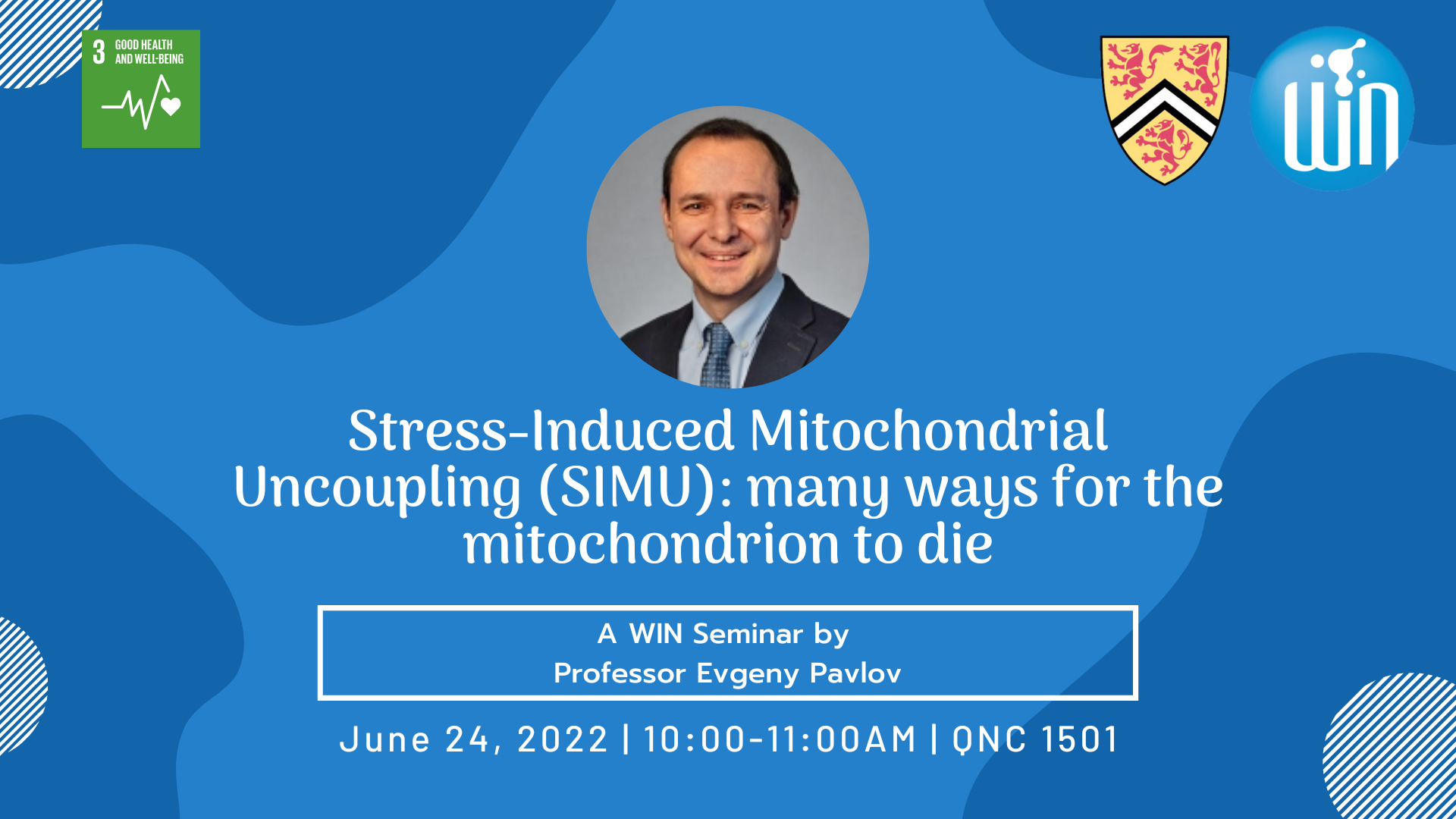
The Waterloo Institute for Nanotechnology (WIN) is pleased to present a WIN Seminar talk by Professor Evgeny Pavlov from the Department of Molecular Pathobiology at the New York University. This seminar will be held in-person in QNC 1501 at 10am on June 24th, 2022.
Stress-Induced Mitochondrial Uncoupling (SIMU): many ways for the mitochondrion to die
Abstract
Mitochondria
are
“power
plants”
that
provide
cells
with
energy
in
the
form
of
ATP.
ATP
generation
by
mitochondria
first
requires
the
generation
of
a
membrane
electrochemical
gradient
on
the
mitochondrial
inner
membrane
by
the
respiratory
chain.
The
energy
of
this
gradient
is
the
driving
force
used
for
ATP
production
by
the
ATP
synthase
enzyme.
This
mechanism
of
ATP
production
–
oxidative
phosphorylation
(OXPHOS)
-
is
the
process
that
supplies
the
bulk
of
energy
to
virtually
all
organs,
including
the
brain
and
heart.
Remarkably,
98%
of
the
oxygen
consumed
by
the
human
body
is
dedicated
to
OXPHOS.
Deprivation of oxygen, even for several minutes, leads to ATP depletion and death, underscoring the vital importance of OXPHOS for physiological functions. One of the essential conditions of the proper OXPHOS function is the requirement that inner membrane permeability remains low. This allows for most of the energy stored in the electrochemical gradient to be used to drive protons back inside mitochondria through ATP synthase in a process coupled to phosphorylation of ADP generating ATP.
Under
normal
conditions,
the
mitochondrial
inner
membrane
is
permeable
almost
exclusively
to
protons.
However,
in
a
broad
range
of
pathologies,
loss
of
mitochondrial
function
and
cell
death
is
linked
to
the
loss
of
mitochondrial
membrane
potential
(and
ATP
generation
capacity)
due
to
the
increase
in
membrane
permeability
in
a
process
that
can
be
described
as
Stress-Induced
Mitochondrial
Uncoupling
(SIMU).
In
my
talk,
I
will
discuss
our
recent
experimental
data
that
allow
us
to
gain
insight
into
molecular
mechanisms
underlying
SIMU.
I
will
also
discuss
the
translational
implications
of
our
findings
in
the
development
of
protective
strategies
against
acute
ischemic
brain
injury.
Biography
I
obtained
my
PhD
in
Biological
Physics
from
the
Russian
Academy
of
Sciences
in
1999.
After
completion
of
the
postdoctoral
training
at
NYU
Dentistry
(2000-2001)
and
University
of
Calgary
(2001-2005),
I
worked
as
a
Research
Assistant
Professor
at
the
University
of
Calgary
and
starting
from
2010
as
a
tenure-track
Assistant
Professor
at
the
Medical
School
at
Dalhousie
University,
Halifax,
Canada.
I
joined
NYU
Dentistry
in
June
2014
as
a
tenure
track
Assistant
Professor
and
became
Associate
Professor
in
2018.
The
main
focus
of
research
in
my
lab
is
on
mitochondria.
In
the
lab,
we
use
several
experimental
approaches,
including
imaging,
electrophysiology
and
respirometry.
We
are
interested
in
understanding
the
roles
played
by
mitochondria
in
cell
death.
In
particular,
we
are
interested
in
understanding
molecular
mechanisms
responsible
for
mitochondrial
damage
during
stress,
resulting
in
loss
of
energy
homeostasis
and
cell
damage.
Our
specific
areas
of
study
include
mitochondrial
ion
channels
and
inorganic
polyphosphate
(polyP)
metabolism.